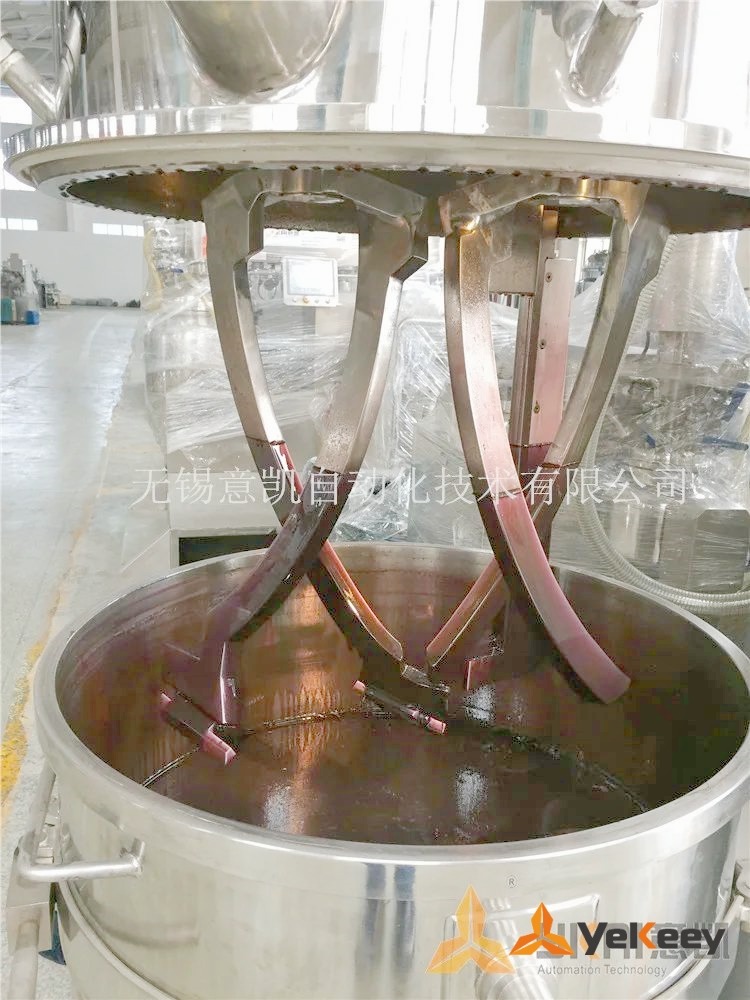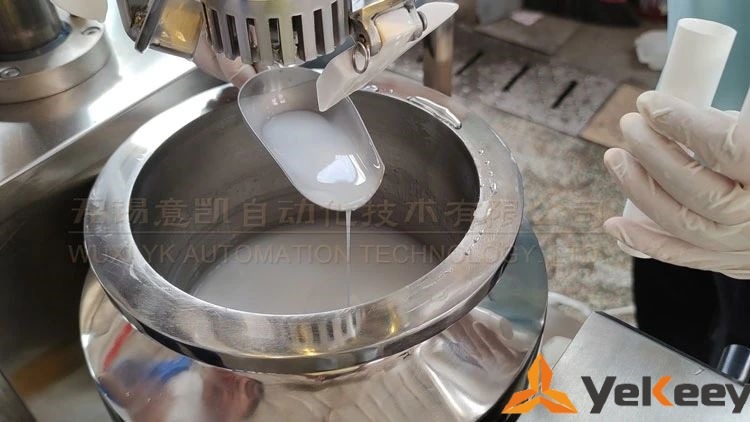-
What is a planetary mixer?
A planetary mixer is a machine that allows materials to flow up, down, and around, thereby achieving a mixing effect in a short period of time.
(1) The planetary mixer has multiple layers of foldable blades inside the tank, which rotate on their own during revolution, allowing the material to flow up, down, and around the tank, achieving the effect of mixing.
(2) The inner wall of the tank is processed by a large vertical lathe and automatically polished by a large polishing machine, ensuring that the movable scraper on the planetary frame can completely scrape off the material on the inner wall of the tank when rotating.
(3) The planetary mixer is particularly suitable for dissolving, mixing, mixing, and reaction processes from powder to high viscosity and density materials.
(4) Different stirring paddles can be selected according to different production processes and material characteristics, such as multi blade type.
(5) In addition, the planetary mixer is also equipped with low-speed mixing components and high-speed dispersion components. The low-speed mixing components use planetary gear transmission to achieve the ideal mixing effect of materials in a short time.
2. How does a planetary mixer work?
The working principle of planetary mixer is based on its unique structure and motion mode. It mainly consists of mixing tanks, mixing paddles, and transmission devices.
(1) In a planetary mixer, the stirring blade usually rotates around the axis of the mixing tank in a planetary motion. This means that the mixing blade not only rotates around its own axis, but also revolves around the axis of the mixing tank. This composite motion mode of revolution and rotation causes strong shear, kneading, and flow effects on the material during the mixing process.
(2) Specifically, the revolution motion causes convection and circulation of materials in the mixing tank, which helps to achieve uniform distribution of materials. At the same time, the stirring force generated by the rotational motion causes strong vortices to form around the stirring blade, which helps with the rapid mixing and dispersion of materials.
(3) In addition, planetary mixers are usually equipped with scraping devices, which can scrape off the materials attached to the inner wall of the mixing tank during the mixing process, thereby avoiding material residue and corners.
3. what is a planetary mixer used for?
Planetary mixers are mainly used for the mixing and homogenization process of high viscosity and high solid content materials. Its unique structure and movement make it particularly suitable for applications in the following fields:
(1) Chemical and Fine Chemicals: Planetary mixers are commonly used for efficient mixing of various chemical raw materials, pigments, dyes, coatings, adhesives, etc.
(2) Pharmaceutical and Biotechnology: In the pharmaceutical industry, planetary mixers are used for mixing and preparing pharmaceutical raw materials, ointments, biomaterials, etc.
(3) Food and Beverage: In the food industry, planetary mixers are used for mixing various food ingredients such as chocolate, jam, seasonings, etc.
(4) New energy materials: In the field of new energy, planetary mixers are commonly used for mixing and preparing materials such as lithium batteries and solar cells.
(5) Electronic and advanced materials: used for mixing and preparing electronic components, nano powder materials, electronic packaging materials, etc.
(6) Other industries: In addition, planetary mixers are widely used in other fields that require efficient mixing, such as ceramics, metallurgy, and environmental protection.
4. What are the features and functions of planetary mixer?
The characteristics of the planetary mixer are as follows:
(1) Efficient mixing: The planetary mixer, through its unique planetary motion, can achieve efficient mixing of materials in a short period of time.
(2) High viscosity adaptability: Planetary mixers are particularly suitable for handling materials with high viscosity and high solid content, and their powerful mixing ability ensures full mixing of materials.
(3) Uniformity: The planetary mixer can ensure uniform distribution of materials during the mixing process, avoiding material layering and agglomeration.
(4) Flexibility: The planetary mixer can adapt to different material and process requirements, and achieve the best mixing effect by adjusting parameters such as mixing speed and blade form.
The functions of the planetary mixer are as follows:
(1) Mixing function: The planetary mixer is mainly used to mix two or more materials to achieve a uniform state.
(2) Dispersion function: Through the high-speed rotating mixing blade, the planetary mixer can disperse the agglomerates in the material into smaller particles, improving the uniformity of the material.
(3) Emulsification function: The planetary mixer can be used to prepare lotion or suspension, so that the oil-water mixture can form a stable emulsion system.
(4) Temperature regulation function: Some planetary mixers are equipped with heating or cooling devices, which can control the temperature of materials during the mixing process to meet specific process requirements.
(5) Cleaning and maintenance: The design of planetary mixers is usually easy to clean and maintain to ensure long-term stable operation of the equipment.









Thank you for the auspicious writeup It in fact was a amusement account it Look advanced to far added agreeable from you However how can we communicate
Please leave your thoughts directly and I will communicate with you in the comments section.